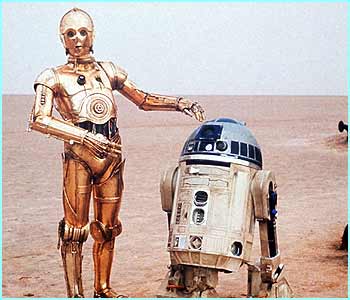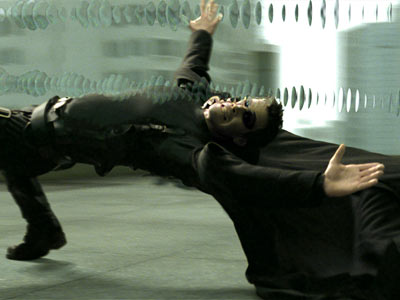A Brief History of Science Fiction Film Music
References, Links, and Works Cited
Created by Jessica Rooney
Last updated 5/1/06


The Matrix (1999)
Use of Sound Effects
Sound effects dominate the soundtrack for The Matrix, while music is mostly incidental and non-lyrical. The music that is used follows classic film techniques, such as the use of fast moving strings and strong bass ostinatos for chase sequences and otherworldly tremelos and sustained dissonances to create feelings of suspense. Yet while the music in The Matrix is more basic in form it does give direction to the audience’s attention and helps them understand how they should be perceiving the very foreign situations that arise. For example, one of the first scenes in which the audience sees that the world is not quite real is when Agent Smith causes Neo’s mouth to grow together. Sonically, the music grows from near silence to a rapid crescendo, creating an immediate sense of wrongness and tension because this crescendo (like the scene) is so unexpected.
Other cues given to the audience includes the use of electronic sounds and silences. There are several different types of electronic sounds heard, each with its own signifier. Electronic static often serves to reveal computer control of reality, as when the young boy bends the spoon in the home of the oracle. Eerie, squeaking electric sounds are reminiscent of horror films and work in the same way to build irrational fear, as when the camera pans over the instruments Agent Smith is using to torture Morphius. An electronic sound caused by digitalized stringed instruments is organic, showing the human corruption by computers as when Cipher is about to pull Neo’s cord during his betrayal. Fast oscillating vibrations produced by strings or electric instruments usually accompanies actions involving machine and computers, as when the computer “harvesters” in the slave real world first see Neo “wake up.” Finally, techno music shows a human control of technology, as seen when songs such as “Clubbed to Death” by Rob Dougan are used during the “Woman in the Red Dress” program in the simulated Matrix (“The Matrix: Music from the Original Soundtrack”).
Another important sound is that of the phones. The ringing of the phones are always louder than the music, breaking silence or causing it. This is startling to the audience because such a recognizable sound is made to sound sinister and disconnected somehow to its surroundings. Significantly, the only time the phone is not louder than the music and dialogue is when Neo is dying and the phone continues ringing in the background, unable to help him reach the real world, as useful as anything else is when constructed in the Matrix.
Silence is also used as an important signifier, especially in scenes with important dialogue. The sudden disappearance of music and sound effect seems to tell the audience to pay close attention to what is being said. This is seen in scenes such as when Morphius first explains the Matrix and when Cipher is in the act of betrayal on the Nebuchadnezzar.

Like sound effects, the music in The Matrix can function as giving aural cues to the audience, especially through its building of suspense. On its own it also helps introduce characters and plot elements. For example, when the audience first hears Morphius on the phone the music becomes strangely comforting. The piano and horns are harmonically minor, but their tones seem strangely cathartic, all-knowing, even prophetic. This musical introduction prepares the audience to automatically trust Morphius even before they know his character or of the full nature of the plot.
The character of Trinity is musically interesting. For most of the film the music does not give her motivic significance, and because she is not singled out by the music her character is made to seem stronger because it can exist within the powerful, edgy musical elements without special circumstances. However, Trinity is the only character who is accompanied with brief phrases of soft, major, comforting music. For example, when she kisses Neo after he comes back to life, the music is beautiful, full of harp, strings, and horns, and promising even as the ship crashes about them.
Neo is not often accompanied by any reoccurring themes in music. However, whenever it is mentioned that he is “the One” or that he is on a quest to defeat the computers the music becomes epic sounding, exhilarating but dangerous. The most notable musical accompaniment for Neo is at the end of the film. Here the soundtrack reverts to the techno song “Rock is Dead” by Marilyn Manson (“ The Matrix: Music from the Original Soundtrack”), seeming to show his conquer of technology and giving a purposeful end to the film.
However, sometimes the music in The Matrix can deceive the audience. When Neo jumps off the roof building in the Matrix simulation program, for instance, the climax of the music leads the audience to believe that he will make the jump. The audience is then surprised and disheartened when he falls, which is important to notice because only a short time before this scene the situation would not have been believable at all.
Back to The Matrix Home